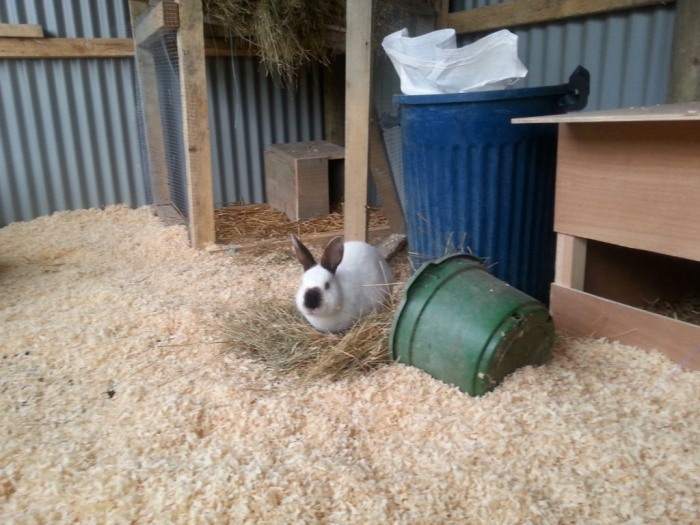This post was most recently updated on February 14th, 2022
Are you planning on raising rabbits in a rabbit colony? Colony raising rabbits isn’t a new idea, but there are some key things to consider for your rabbit colony setup. In this article we discuss how to plan the very best rabbit colony for your situation.
Please read: This information is provided for educational purposes only and is not intended to treat, diagnose or prevent any disease. We encourage you to make your own health care decisions in partnership with a qualified health care professional.
This post contains affiliate links, this means at no extra cost to you, we make a commission from sales. Please read
our Disclosure Statement
We are raising meat rabbits in a colony. I am not entirely sure how we got to this particular point where I thought raising meat rabbits was a good idea, but somewhere along the line, I read some facts about bunnies that made me want to give it a go.
What is a Rabbit Colony?
A rabbit colony is typically group housing for rabbits where they live together in a more natural manner. Usually a colony will consist of a fenced area or shed with either dirt or deep bedding on the floor and either man made shelters or space for the rabbits to create their own burrow and feeding areas.
Breeding in a rabbit colony usually happens naturally, with the does generally controlling when they wish to be bred.
Jump to:
Why Not Cage Raise?
Why Should You Raise Your Own Rabbits
Raising Meat Rabbits in a Colony
Shed Colony
How Much Room Do I Need?
Designing a Rabbit Colony
Feeding in a Rabbit Colony
Keeping a Rabbit Colony Clean
Introducing New Rabbits to your Colony
If you want to know more about why we chose to raise meat rabbits on our homestead read 5 Reasons to Raise Meat Rabbits. We have chosen to raise colony rabbits rather than caged ones, read on to find out why.
Why keep rabbits in a colony and not in cages?
Like chickens, commercial meat rabbits can be kept in cages and bred intensively. Rabbits are naturally social and love to run, play and frolic in social groups known as a ‘fluffle’.
Domestic rabbits are different to the solitary cotton tail found in the wild in the USA.
Keeping rabbits in an individual cage is more common when people raise for rabbit meat, but a wire cage can easily be swapped for pasture based colonies in many circumstances.
Good rabbit husbandry calls for keeping rabbits warm, dry, and out of their own filth, while providing appropriate food and water as well as social interaction. All of these can be achieved with a well planned rabbit colony setup.
I remember as a child going with my mother to pick up a pet rabbit for the kindergarten she worked at. The lady we got it from had a small shed that you walked into and there were rabbits and guinea pigs all over the place.
It was quite fantastic. They all looked so happy and free, and they were very friendly. I decided if I was to get rabbits that is how I would like to keep them.
When we first got married our first pet was a rabbit we named Nudge Montgomery. Nudge was a real character, and he lived in a puppy pen in the house, and we often let him out for a good run around. He was a truly happy bunny.
When your grandparents were young having meat rabbits in the backyard was commonplace. In fact, rabbits have been bred for meat for hundreds, maybe thousands of years.
That was before we all decided to pay someone else to do the hard part of raising/dispatching our meat, so we can pick it up from the grocer and not have to think about how it got there or how it lived.
We have become so far removed from our food, we really have no idea about the process or control over their environments anymore.
Why Should You Raise Your Own Meat Rabbits
Backyard meat rabbits are making a comeback. A BIG comeback. They are small, quiet, cheap and easy to raise, so you can have them in your backyard and your neighbors would be none the wiser.
You can feed them what you want them to eat, and you know that they have lived a fantastic life, with only one bad day. That, my friends, is happy meat. Ethical meat. My kind of meat.
New Zealand rabbits are the breed most commonly kept as meat rabbits, and with very few exceptions, they adapt well and quickly to colony life.
RELATED: Naturally feeding rabbits
Benefits to keeping meat rabbits in cages:
Caged rabbit housing does have some benefits, especially if you are breeding rabbits. Cages might be hanging cages or an individual rabbit tractor.
- They are easy to catch.
- It is super easy to keep clean as the poop falls through the cage.
- It is easier to keep them cool – heat kills more rabbits than the cold does.
- They don’t fight when they don’t get the opportunity to do so.
- And you can stack many many cages into a space.
The downside to individual cages are many
- The initial setup cost is more.
- The ongoing feeding/watering takes a long time each day.
- The rabbits don’t have the room to run and play.
- They have less muscle tone.
- They don’t get to be social like rabbits like to be.
Planning the BEST Rabbit Colony Setup
There are several options for colonies for rabbits. They range from a double sized cage/chicken tractor and housing 2 or 3 does together, to a well-fenced paddock to keep predators out and rabbits in allowing them to live in self-dug ground holes.
Which style of colony you decide depends on your resources and land you have available, as well as your preferences. A small shed can easily convert to a colony pen, especially if you add a deep litter system.
RELATED: Raising meat rabbits – your top 5 questions answered
Top tips for keeping a rabbit colony
There are some key takeaways that you need to know about setting up a rabbit colony at your place:
- Use a roof to protect your rabbits from weather and predators
- If you are using wire fencing use baby saver wire around the bottom
- Keep your colony clean by using litter boxes and deep litter
- Reduce competition for feed by providing several feed and water stations
- Does like to choose where they nest, and the more options the better
- Bucks can live with your does as long as you don’t need to predict the timing of litters
- Provide at least 10 square feet per adult, twice that for breeding female rabbits
- Bunnies love to run and jump so multiple levels for jumping helps keep them entertained
- You can pull weaned grow-outs out to their own pen to increase their food consumption and reduce congestion in the colony
- Keep your plan flexible, you can change it up if something is no longer working
- Rabbit colonies work well for both meat rabbits and pet rabbits
How to set up a rabbit colony
There are a multitude of ways to set up a rabbit colony, but all must allow at least 1 sq meter / 10 sq feet per adult rabbit, and twice that for a breeding doe. So you could easily fit a breeding pair in a 3m2 or 30sq ft area. The more does you have, the more space per doe you will want to include to minimize fighting. Ideally you will only have one buck per colony unless your areas are very large. One buck can easily service 10-20 does.
Outdoor Rabbit Colony
This style of colony housing involves digging a 600mm (2ft) deep trench all around the edge of the paddock and burying roofing tin, heavy duty geotextile or chicken wire or netting to stop them digging out.
In NZ and Australia, you will need to then leave the paddock fallow for 3-4 months to ensure RCD virus dies before you introduce your rabbits.
To save having to dig right around the perimeter some people are having success with filling the colony with 300mm of very rocky fill – broken bricks, rocks, large gravel.
Not only does this strongly discourage digging but it improves drainage substantially. In the middle of this sort of set up, you can then add a truckload or two of top soil and allow the rabbits to burrow into it.
Ground burrows protect from both heat and cold without air-conditioning, they are protected from wind, rain and flying predators.
RELATED: why you should let your rabbits burrow
The good bacteria that live in the soil will build your rabbit colonies babies immunity and you will end up with a much more robust baby rabbit when they are raised this way.
In England in the 1600s-1700s+ they would maintain warrens, and use ferrets, rats or terriers to flush out the rabbits.


These days I suggest you simply feed your rabbits in a designated area in the colony that can be shut off/made smaller when you need to catch your rabbits.
Rabbit Colony in a shed or barn
Somewhere in the middle between a shared hutch and a paddock is what we have chosen to be so we have a shed colony.
This eliminates the contact with wild rabbits, minimizing the RCD (and other diseases) risk, and is a manageable size for our first time.
Flooring options for indoor houses include concrete, pavers or bricks, dirt covered in welded wire/geotex fabric or stall mats. Each has its own merits, and cost, go with the best that you can afford.
We have a combination of free bricks on one half and wire with bricks around the edge on the other half, both sides have dirt underneath.
The wire eventually rusted enough for them to dig through after 6 years, so we have replaced it with a layer of corrugated roofing iron and covered it in bedding, so far it is working well.
The upside to the dirt underneath is that any spilled water or bunny urine can simply soak into the earth, this minimizes the stench.
How Much Room Do I Need for a Rabbit Colony?
To work out what sized space you need is a little confusing. NZ doesn’t appear to have legal minimal caging size requirements, but it does refer to the American standards.
For individual cages most people allow 1m2 per adult rabbit (10sq ft). In a colony you need to allow a mama rabbit twice this size to account for her baby rabbits.
If you move your grow-outs (weaned growing babies) to another area they get half the allocated space of an adult rabbit each as meat rabbits are moved on before they reach their adult size.
MATHS TIME: Our shed, is 9.89m2/106 sq ft (if it is under 10m2 in NZ you don’t need building consent to build it).
One of these adults is my buck so he just needs 1m2. So that leaves 9m2 for the mamas. 9 /2= 4.5. So in my 10m2 shed I could fit 4 does and my buck and their babies up to 12 weeks old quite happily, with 1m spare for them to share around.
You can reverse this to work out how much space you would need for x number of rabbits as well. Where D is does and B is bucks based on an average of 8 kits per doe.
METRIC: m2 = (1 x B) + (2 x D)
IMPERIAL: sq ft = (10 x B) + (20 x D)
Designing a Rabbit Colony
You can increase the floor space by building vertically, I plan on adding a few .8m wide shelves for them to climb on, rabbits love being up high.
My nesting boxes are also designed with the thought that they might like to climb on top of them and jump off them.
They love having obstacles and tunnels and things to play with. You can make beds out of rubbermaid totes or old pet carry crates with their doors removed. They also like big truck tires.
Give them plenty of wood that they can chew – apple, pear, untreated pine, willow, and birch are all safe choices.
Rabbits like to lie in dust, it helps kill off parasites. Give them a dust wallow with some sand, dry dirt and hand full of wood ash and a handful of diatomaceous earth – the same blend you give chickens for the same thing. You can add some sage and lavender crushed up too if you like. These will all help repel/kill the cretins that annoy your rabbits. For more on
You can add some sage and lavender crushed up too if you like. These will all help repel/kill the cretins that annoy your rabbits. For more on parasite control read here.
Given a large stack of bales of hay or straw the rabbits will burrow in and make their nests in there. But so will the local mice/rat population.
Some people might say why not just free range rabbits in your backyard. The reason not to do this is really two fold – 1) it is illegal in most places that have a wild rabbit problem like Australia and New Zealand and 2) Predators are likely to take out your rabbits if they don’t have a safe place to call their own.
Feeding in a Rabbit Colony
Communal feeding areas should be well spaced out so there are no fights, and have 2 water sources for the same reason.
Rabbits do well on a balanced natural diet. If you choose you can use purely commercial rabbit pellets, or a mixture of the two. A J feeder at each station is a economic way to ensure the growing rabbits have access to as much food as they need while limiting the waste. We have also successfully used hanging chicken feeders with both rabbit pellet or whole grain food.
Keeping a Rabbit Colony Clean
If you are using a shed, I suggest you employ the ‘deep litter method’. Find yourself a source of cheap or free bedding material – pine shavings or straw work well.
Rabbit droppings harbor diseases like coccidiosis, so ensuring that fresh bedding is added to cover these regularly is crucial to the health of your rabbitry.
Put 20-30cm (8-12 inches) of bedding down over a dusting of barn lime and diatomaceous earth. The lime will reduce/neutralize the ammonia pee smell and the diatomaceous earth helps keep flees, mites and ticks at bay.
Adult rabbits will tend to use one or two areas as the toilet. Baby rabbits will go where they stand, so raking over the top layer of deep litter daily is helpful.
Only disturb the bottom when you plan to it clean out. I do this every 3 months, but if you keep adding fresh bedding on top, you can get away with the big clean out once a year.
The smaller your rabbit pen, the more often you will need to clear it out.
If you are going the whole hog and doing a large shed or paddock, a dirt floor sown in grass/feed/barley that you can simply hose now and again to soak in the pee/poop works well.
Placing a raised area covered in small wire under the rabbit feed and under the waterer will allow the poops they do while eating and drinking fall away, helping to keep the area cleaner.
Keep nesting boxes free of poop while they aren’t occupied with a litter of kits, a nesting box makes an appealing litter box!
Introducing New Rabbits to your Colony
To minimize fighting in the colony you need to provide plenty of hiding places and several food/water stations to minimize competition.
It is also best if you can introduce everyone at the same time to the space, so no one has time to claim the territory first. Young rabbits are less likely to fight, but then you cannot buy one that is “proven” ie has already had a litter.
If you are introducing a new rabbit to your colony, it is recommended that they go into quarantine for 35 days first, somewhere away from your main rabbits like a hutch on your lawn.
Always feed/tend to the quarantined rabbit last so as not to share around any potential disease with your own stock.
Once the quarantine period is over, try introducing your rabbit in a pen within your colony first for a week or two so they get used to each other. A dog crate or puppy pen is ideal. Then let them out and watch closely for scuffles – you can squirt the perpetrator with a water bottle if scuffles are getting serious.
After a few smooth supervised outings you can let them join the fluffle (yes a group of multiple rabbits is called a fluffle, cute right?). Keep an eye out for injuries or piles of fur that might suggest a fight.
Some rabbits adjust really well, others will never adjust. Sometimes it is easier to remove or cull the dominant/bully as they probably cause unrest for all the occupants of your colony anyway.
Related: The Ultimate Guide to Raising Meat Rabbits In Colonies.
Do you keep your rabbits in a colony? Tell me about your setup in the comments below!
Want to know all about raising rabbits in a colony?
Check out our very own book here:
Available on Kindle and in paperback or from our store
Please Pin and Share!

















